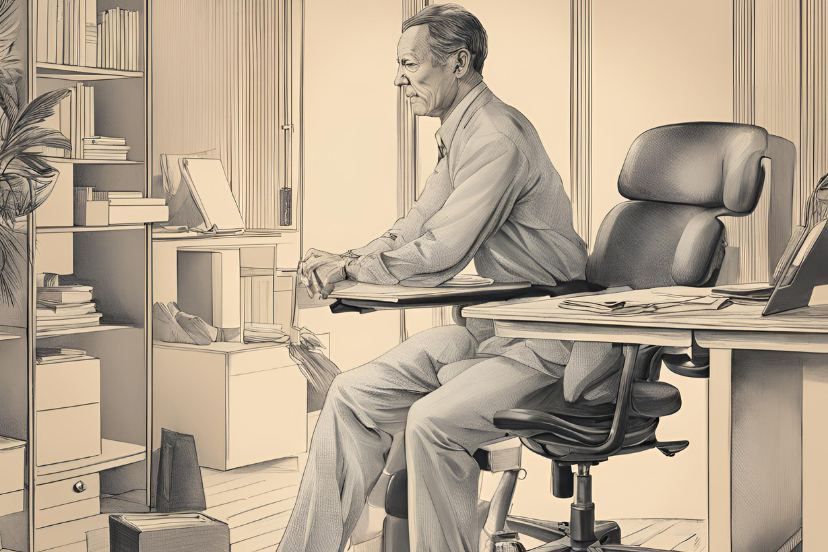Sciatica Relief for Office Workers
Sciatica relief for office workers: Discover effective tips for pain relief, ergonomic setups, and stretches to ease discomfort and stay productive. Sciatica is a condition that affects millions of people worldwide, causing pain, numbness, and discomfort that often radiates from the lower back down to the legs. For office workers who spend long hours sitting at a desk, the risk of developing or exacerbating sciatica increases significantly. This article provides actionable strategies for managing and preventing sciatica, tailored specifically for office workers.
Understanding Sciatica
Sciatica occurs when the sciatic nerve—the longest nerve in the body—becomes compressed or irritated. This can result from herniated discs, bone spurs, or spinal stenosis. For office workers, prolonged sitting and poor posture are common triggers.
Symptoms of Sciatica:
- Lower back pain
- Shooting pain down one leg
- Numbness or tingling in the leg or foot
- Weakness in the affected leg
Understanding these symptoms is the first step toward finding relief.
The Link Between Office Work and Sciatica
Office work often involves sitting for extended periods, which can:
- Increase pressure on the lower back and spinal discs
- Cause tightness in the hip flexors and hamstrings
- Contribute to poor posture
Over time, these factors can lead to sciatica or worsen existing symptoms.
The Perfect Ergonomic Desk Setup
Tips for Sciatica Relief in the Office
Here are practical steps office workers can take to alleviate sciatica pain and improve overall spine health:
Ergonomic Workspace Setup
Chair: Use an ergonomic chair that supports the natural curve of your spine. Adjust the height so your feet rest flat on the floor and your knees are at a 90-degree angle.
Desk and Monitor: Position your monitor at eye level to avoid straining your neck. Keep your keyboard and mouse within easy reach to prevent hunching.
Footrest: If your feet don’t reach the floor, use a footrest to maintain proper alignment.
Take Regular Breaks
Sitting for long periods compresses the spine. Set a timer to remind yourself to stand, stretch, and move every 30-60 minutes. Incorporate simple stretches like:
- Standing hamstring stretch
- Cat-cow stretch
- Seated spinal twist
- This weird stretch
Practice Good Posture
Maintain a neutral spine position by:
- Keeping your shoulders relaxed and back
- Engaging your core muscles
- Avoid crossing your legs, which can misalign the spine
Incorporate Movement into Your Day
- Walk during lunch breaks or take phone calls standing up.
- Consider a sit-stand desk to alternate between sitting and standing throughout the day.
Strengthen Core Muscles
A strong core supports the spine and reduces sciatica risk. Incorporate exercises like:
- Planks
- Bird-dog
- Pelvic bridges
At-Home Strategies for Sciatica Relief
Office workers can also take steps outside of work to manage sciatica symptoms:
Stretch Daily
Stretching helps reduce muscle tightness and improve flexibility. Focus on stretches targeting the lower back, hamstrings, and hips.
Pigeon pose: Opens up the hips
Child’s pose: Relieves lower back tension
Figure-four stretch: Loosens the piriformis muscle
Apply Heat or Cold Therapy
- Use a heating pad to relax tight muscles and improve blood flow.
- Apply an ice pack to reduce inflammation and numb acute pain.
Maintain a Healthy Weight
Excess weight puts additional stress on the spine. Adopting a balanced diet and regular exercise routine can help alleviate this pressure.
Sleep Position Adjustments
- Sleep on your side with a pillow between your knees.
- Use a supportive mattress to keep your spine aligned.
When to Seek Professional Help
While these strategies can provide significant relief, it’s essential to seek professional help if:
- Pain persists or worsens despite self-care efforts
- You experience severe numbness or weakness
- Symptoms interfere with daily activities
Consult a physical therapist or chiropractor for targeted treatments, such as:
Manual therapy: To improve joint mobility and reduce nerve compression
Guided exercises: To strengthen specific muscle groups
Advanced treatments: Such as spinal decompression therapy or corticosteroid injections
Preventing Sciatica for Office Workers
Prevention is always better than a cure. Here are proactive steps to reduce the risk of sciatica:
Invest in Quality Office Equipment
Spending on ergonomic furniture and accessories is a worthwhile investment for your long-term health.
Stay Physical Active
Regular physical activity, such as walking, yoga, tai chi, or swimming, can strengthen your muscles and improve flexibility.
Focus on Posture
Develop habits to maintain proper posture, both at work and during daily activities.
Listen to Your Body
Pay attention to early signs of discomfort and address them promptly to prevent escalation.
Effective Stretches for Sciatica Relief
Here are detailed instructions for stretches that office workers can perform:
Seated Piriformis Stretch
- Sit on the edge of your chair.
- Place your right ankle over your left knee.
- Lean forward slightly, keeping your back straight until you feel a stretch in your right hip.
- Hold for 20-30 seconds and switch sides.
Desk Hamstring Stretch
- Stand a few feet away from your desk.
- Place your right leg straight on the desk, keeping your toes pointing upward.
- Lean forward gently to stretch the hamstring.
- Hold for 20-30 seconds and repeat on the other leg.
Standing Hip Flexor Stretch
- Stand in a lunge position with your right foot forward.
- Lower your left knee to the ground.
- Push your hips forward slightly until you feel a stretch in your left hip.
- Hold for 20-30 seconds and switch sides.
The Role of Nutrition in Sciatica Management
A healthy diet can support sciatica relief by reducing inflammation and promoting nerve health. Include these foods in your meals:
Omega-3 fatty acids: Found in salmon, walnuts, and flaxseeds
Antioxidants: Present in berries, leafy greens, and citrus fruits
Magnesium-rich foods: Such as almonds, spinach, and avocados
Avoid processed foods and sugary snacks that can exacerbate inflammation.
Embracing a Holistic Approach
Combining physical adjustments, lifestyle changes, and professional guidance can lead to lasting relief from sciatica. For office workers, the key lies in creating an environment and routine that supports spinal health.
FAQs Related to Sciatica Relief for Office Workers
Can a standing desk help with sciatica?
Yes, alternating between sitting and standing using a sit-stand desk can reduce pressure on the lower back and promote better posture, alleviating sciatica symptoms.
Is it safe to exercise with sciatica?
Yes, gentle exercises like walking, swimming, or yoga can help reduce pain and strengthen supporting muscles. Consult a healthcare professional for personalized advice.
Can sciatica return after it’s resolved?
Sciatica can recur if the underlying causes, such as poor posture or prolonged sitting, are not addressed. Preventive measures like regular movement and ergonomic adjustments can help reduce the risk of recurrence.
What type of chair is best for sciatica?
An ergonomic chair with lumbar support and adjustable height is ideal. Ensure that the chair allows your feet to rest flat on the floor and supports the natural curve of your spine.
Are there specific exercises to avoid if I have sciatica?
Avoid high-impact activities and exercises that involve heavy twisting or bending of the spine, such as sit-ups or heavy deadlifts, as they can worsen symptoms.
How long does it take for sciatica to improve with these strategies?
Improvement varies depending on the severity of your condition and consistency with self-care. Many people notice relief within a few weeks of implementing ergonomic and movement strategies.
What is the fastest way to relieve sciatica pain at work?
Taking short, frequent breaks to stretch and move can provide immediate relief. Try simple stretches like the seated piriformis stretch to reduce tension in the affected area.
Sciatica Relief for Office Workers – Final Thoughts
Sciatica can be debilitating, but with the right strategies, office workers can find significant relief and improve their quality of life. By addressing ergonomics, incorporating movement, and adopting a proactive approach to health, you can prevent and manage sciatica effectively. Remember, small changes in your daily routine can make a big difference in your spinal health.
Take action today to prioritize your well-being and bid farewell to the discomfort of sciatica.
Disclaimer
Please note that this article should not replace professional medical advice. Consult a healthcare professional for an accurate diagnosis and tailored treatment plan.






